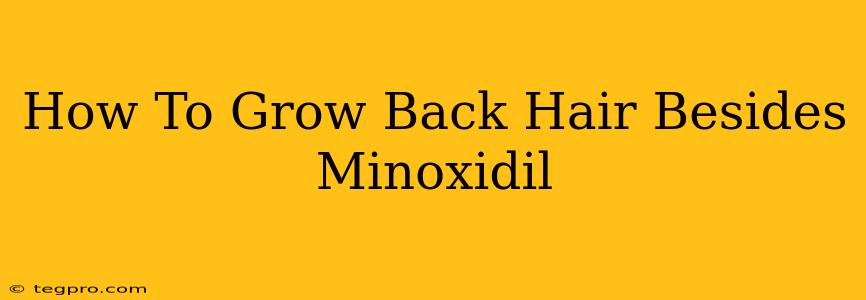Minoxidil is a popular topical treatment for hair loss, but it's not the only option. Many people seek alternative methods to regrow their hair, and luckily, several effective strategies exist. This guide explores proven ways to stimulate hair growth naturally and through other medical interventions, providing a comprehensive approach to hair regrowth beyond Minoxidil.
Understanding Hair Loss & Regrowth
Before diving into solutions, it's crucial to understand the causes of hair loss. Common culprits include:
- Androgenetic alopecia (male/female pattern baldness): A genetic condition leading to miniaturization of hair follicles.
- Telogen effluvium: Temporary hair shedding triggered by stress, illness, or hormonal changes.
- Alopecia areata: An autoimmune disorder causing patchy hair loss.
- Medication side effects: Certain drugs can contribute to hair thinning.
- Nutritional deficiencies: Lack of essential vitamins and minerals can impact hair health.
Knowing the underlying cause is vital in determining the most effective treatment. While Minoxidil addresses some causes, others might require a different approach.
Natural Ways to Promote Hair Growth
Several natural methods can support hair regrowth and improve overall hair health:
1. Diet and Nutrition: Fueling Hair Growth from Within
A balanced diet rich in protein, vitamins, and minerals is essential for healthy hair growth. Focus on foods containing:
- Protein: Essential for hair structure. Include lean meats, fish, eggs, beans, and lentils.
- Biotin (Vitamin B7): Supports keratin production, a key component of hair. Found in eggs, nuts, and sweet potatoes.
- Iron: Prevents anemia, which can contribute to hair loss. Good sources include spinach, red meat, and beans.
- Zinc: Important for hair follicle function. Found in oysters, nuts, and seeds.
- Vitamin D: Plays a role in hair follicle cycling. Obtain through sunlight exposure or supplements (consult a doctor).
Pro Tip: Consider a multivitamin if you suspect nutritional deficiencies. A blood test can help identify specific areas needing improvement.
2. Scalp Massage: Stimulating Hair Follicles
Gentle scalp massage increases blood flow to the hair follicles, potentially stimulating growth. Massage your scalp for a few minutes daily using your fingertips. You can also use essential oils like rosemary or peppermint during the massage.
3. Essential Oils: Promoting Hair Health
Several essential oils have shown promise in promoting hair growth. Rosemary and peppermint oil are particularly popular. Always dilute essential oils with a carrier oil (like coconut or jojoba oil) before applying them to your scalp.
4. Low-Level Laser Therapy (LLLT): A Non-Invasive Approach
LLLT devices use low-level lasers to stimulate hair follicles. Studies suggest it can be effective in treating androgenetic alopecia. These devices are available for home use. Consult your doctor before using LLLT.
Medical Interventions Beyond Minoxidil
Besides Minoxidil and natural remedies, other medical options might be considered:
1. Finasteride: An Oral Medication
Finasteride is an oral medication that blocks the conversion of testosterone to dihydrotestosterone (DHT), a hormone implicated in male pattern baldness. It's generally prescribed for men. It's crucial to discuss potential side effects with your doctor.
2. Hair Transplant Surgery: A Permanent Solution
Hair transplant surgery involves moving hair follicles from a donor area to a balding area. It's a permanent solution but requires surgery and carries potential risks. Consult a qualified hair transplant surgeon for evaluation.
3. Platelet-Rich Plasma (PRP) Therapy: Stimulating Natural Growth
PRP therapy involves injecting concentrated platelets from your own blood into your scalp. The platelets contain growth factors that can stimulate hair follicle growth. It's a relatively new treatment, and more research is needed.
Conclusion: A Holistic Approach to Hair Regrowth
Regrowing hair requires a multifaceted approach. Combining natural remedies like a healthy diet and scalp massage with medical interventions like LLLT or potentially Finasteride, can significantly improve your chances of success. Remember to consult with a dermatologist or healthcare professional to determine the underlying cause of your hair loss and to discuss the best treatment plan for your individual needs. Don't rely solely on one method; a holistic approach incorporating several strategies tailored to your situation is often the most effective way to encourage hair regrowth.

